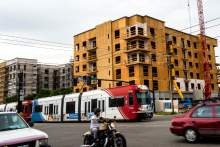This is an archived article that was published on sltrib.com in 2015, and information in the article may be outdated. It is provided only for personal research purposes and may not be reprinted.
Mass transit may aim mostly to move people efficiently and reduce traffic congestion and pollution. But a new study looking at Utah says rail expansion also attracted plenty of firms and development that created hundreds of jobs.
"TRAX and FrontRunner rail lines are attributed with spurring development that has resulted in nearly 1,300 net new jobs generating over $66 million in income and $227 million in business sales annually," says a new report by the Boston-based Economic Development Research Group.
The study was commissioned by Siemens, the manufacturer of TRAX light-rail cars. It was released this week at the rail conference of the American Public Transportation Association held in Salt Lake City — where transit officials talked about stressing economic benefits of their projects to push for more federal funding.
The study said it tried to look beyond the short-term business and job benefits caused by the construction of new TRAX and FrontRunner lines, and looked at long-term economic impacts.
"Major companies including Adobe, eBay, Goldman Sachs, Overstock.com and Workday have made office-location decisions based in part on proximity to TRAX and FrontRunner stations," it said.
Beyond direct wages and business sales, supplier purchases and employee spending raised the total annual impact on Salt Lake County's economy "to nearly 2,800 jobs, close to $136 million in income, and over $410 million in business sales annually," it said.
The study adds that those estimates "reflect only some of the economic development impacts associated with the $7 billion of private investment made near transit stations."
The Utah Transit Authority spent $2.5 billion to add 70 miles of new rail in five years from 2008 to 2013 by completing a FrontRunner extension to Provo and TRAX extensions to Salt Lake City International Airport, West Valley City, South Jordan and Draper.
"Rail projects like these are proof that when you spend on infrastructure, you get a multiplier effect that boosts productivity and attractiveness for investment," said Michael Cahill, president of Siemens Rolling Stock.
A press release by Siemens included quotes from several local officials hailing the economic and other impacts of those rail projects.
"The economic development along our lines has been steady and a huge benefit to the entire community," said UTA President and CEO Michael Allegra.
Salt Lake City Mayor Ralph Becker said the transit projects have been "integral in our efforts to get cars off the roads, address local air quality challenges and continue to improve the livability, and sustainability, of our community."
Abby Albrecht, director of the Utah Transportation Coalition, created by the Salt Lake Chamber to push transportation improvements, said, "Utah's economy is leading the nation and this report shows part of our success can be attributed to our commitment to transportation investment as a state."
She added, "As we look to the future, building on these investments wisely will ensure we continue to economically prosper."
The report comes as residents may be asked soon — possibly as early as this November — whether to approve a sales tax increase for transportation. Forty percent of that money would go to UTA for transit in counties where it operates, and the rest would go to cities and counties for roads.
Scores of cities statewide have been passing resolutions asking counties to put a proposed tax increase — one-quarter cent per $1 purchase — on the ballot this year. Counties must decide whether to do that by early August to make the Nov. 3 ballot.
UTA has said it would use money from such an increase mostly to expand bus routes and extend bus service hours at night and on weekends. Bus service was reduced to help pay for the expansion of rail lines during the recession.



